Justices of the Supreme Court
* List is ordered by their first elected or appointed date, with the current Justices at the top
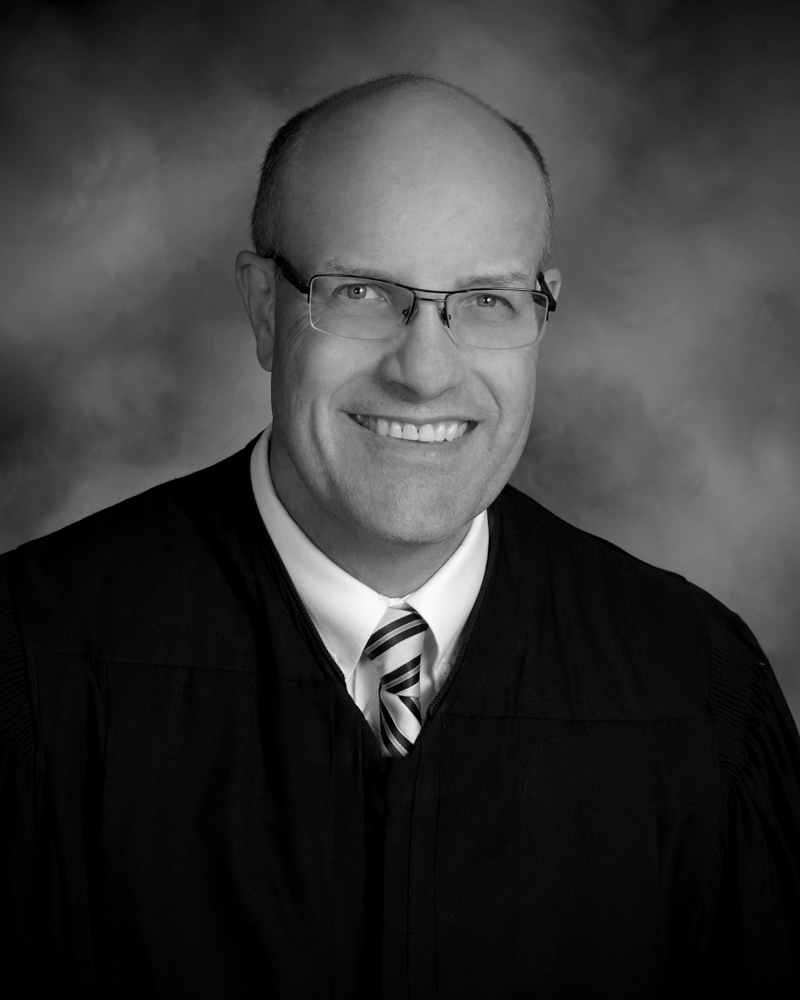
Douglas A. Bahr
Justice of the Supreme Court
Appointed: 2023 - Present
B.S. degree from Brigham Young University (1987). J.D. degree from the University of South Dakota (1990). Judicial Clerk for the Honorable Jerry L. Larson, Justice, Iowa Supreme Court (1990 – 1991). Served nine years as an Assistant Attorney General and sixteen years as the North Dakota Solicitor General and Director of the Civil Litigation Division of the North Dakota Office of Attorney General (1991-2016). In private practice in Bismarck (2016 to 2018).
Former president, State Bar Association of North Dakota. Former president, State Bar Association of North Dakota Ethics Committee. Former president, Association of the Bar of the United States Court of Appeals for the Eighth Circuit.
Appointed District Judge September 2018 by Gov. Doug Burgum. Elected 2020; Reelected 2022. Chair of the North Dakota Courts’ Personnel Policy Board. Member of the North Dakota Courts’ Joint Procedure Committee.
Married to Laura, 6 children.
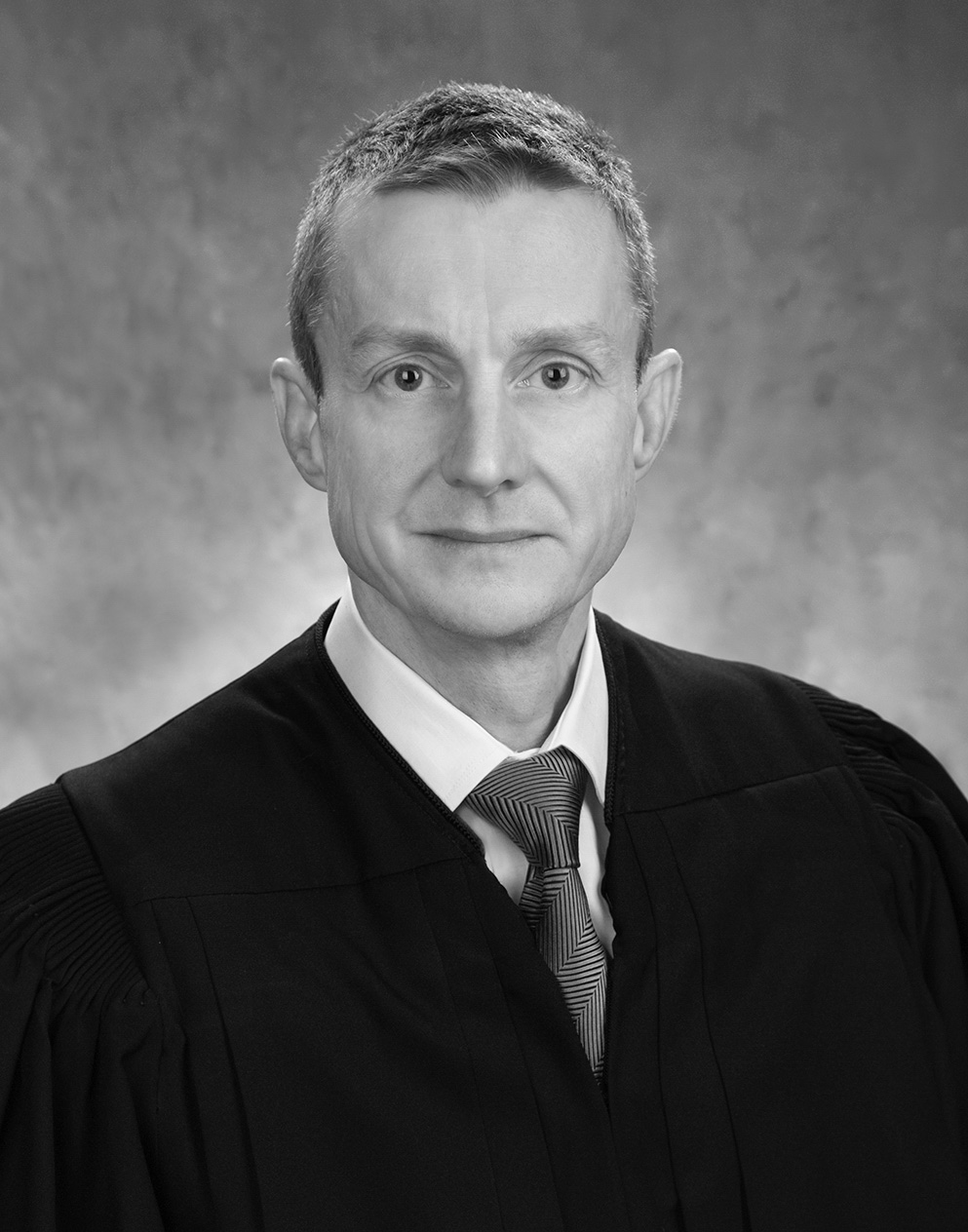
Jon J. Jensen
District Court Judge/Chief Justice
Appointed: 2017 - Present
Chief Justice Jensen was appointed as District Court Judge by Governor Jack Dalrymple in 2013 for the Northeast Judicial District located in Grand Forks, ND. He was elected in 2016. He was appointed by Governor Doug Burgum in 2017 to the North Dakota Supreme Court to fill the vacancy created by Justice Carol Ronning Kapsner's retirement. He was then elected by the North Dakota District Court Judges as Chief Justice of the North Dakota Supreme Court on January 1, 2020.
Born in 1965; Chief Justice Jensen is a native of Grand Forks, N.D. He graduated from Minnesota State University Mankato in 1987 and received his Juris Doctor from the University of North Dakota School of Law in 1990. He was admitted to the N.D. Bar on October 23, 1990.
He was in private legal practice in Grand Forks from 1991 until his judgeship in 2013.
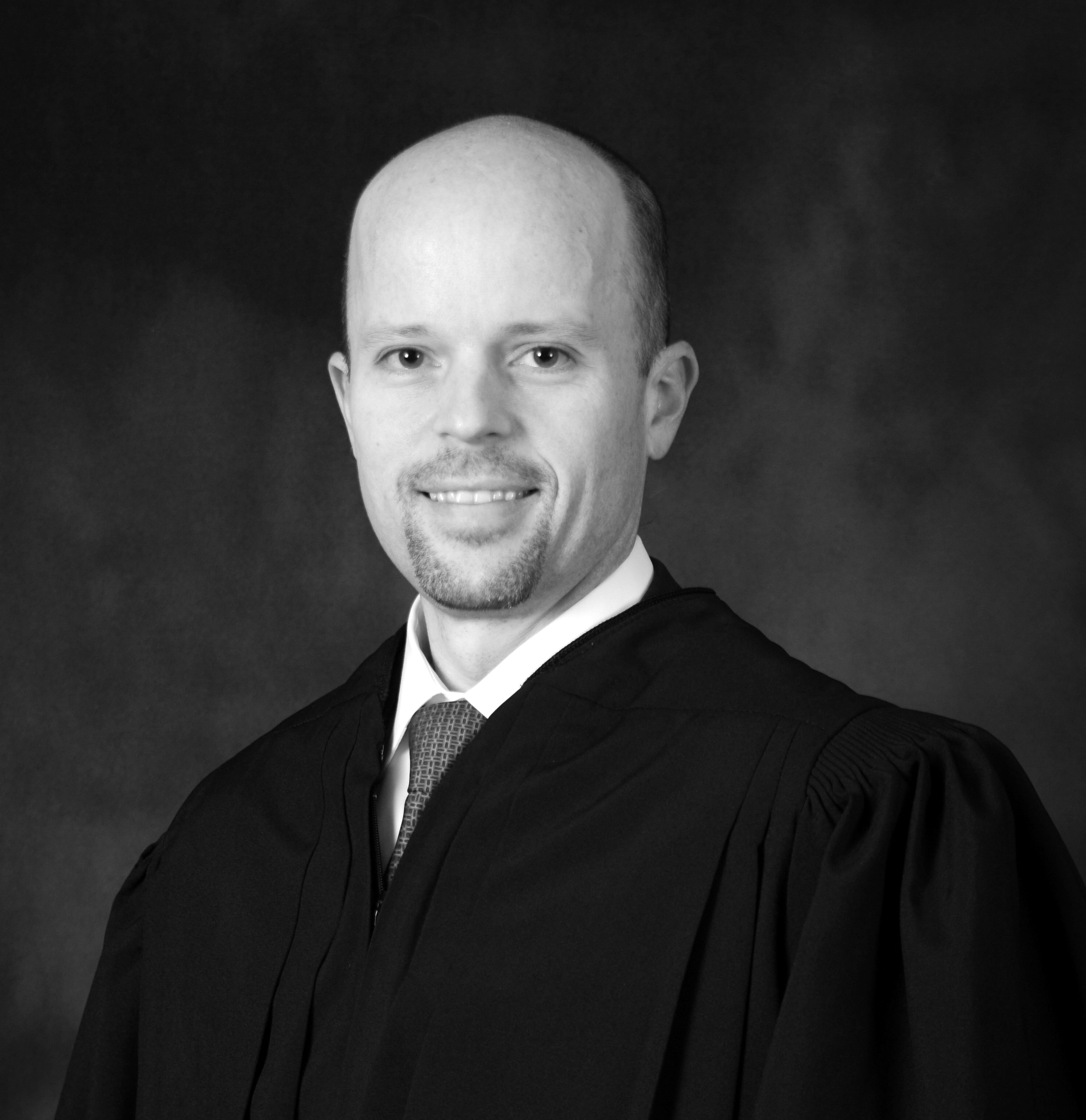
Jerod E. Tufte
District Court Judge/Justice of the Supreme Court
Elected: 2017 - Present
Born in 1975 in Minot, N.D. J.D., Arizona State University College of Law 2002. B.S., Computer Engineering, Case Western Reserve University, 1997. Legal counsel to Gov. Jack Dalrymple, 2011-2014. JAG officer, N.D. Army National Guard, 2008-2016. In private legal practice in Steele, 2005-2011. Kidder County State's Attorney 2005-2011, Sheridan County State's Attorney, 2011. In private legal practice in Phoenix, Arizona, 2003-2005. Law clerk to Judge Roger Wollman, United States Court of Appeals for the Eighth Circuit, 2002-2003. Appointed District Judge in July 2014. Elected Justice of the Supreme Court in 2016 taking office on January 1, 2017. Married, three children.
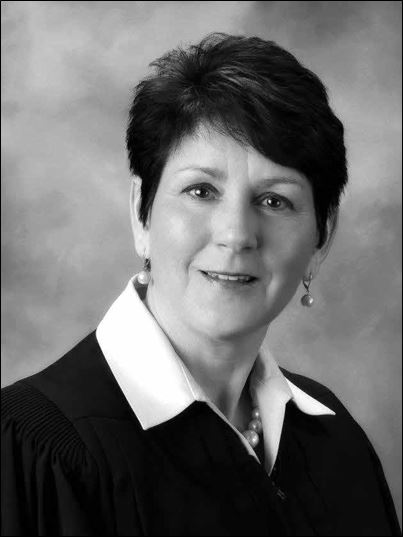
Lisa K. Fair McEvers
District Court Judge/Justice of the Supreme Court
Appointed: 2014 - Present
Justice McEvers was appointed by Governor John Hoeven as District Court Judge to the East Central Judicial District in 2010 and elected to the position in 2012. She was then appointed by Governor Jack Dalrymple to the North Dakota Supreme Court on January 1, 2014. She was elected in 2016, and re-elected in 2018.
Born in 1962; Justice McEvers is a native of Minto, North Dakota. She earned her Bachelors in Business Administration in Information Management from the University of North Dakota in 1993. She received her Juris Doctor from the University of North Dakota School of Law in 1997, and was admitted to the N.D. Bar on October 6, 1997.
Justice McEvers served as a law clerk to the North Dakota Supreme Court during the 1997-1998 term. She worked in private legal practice from 1998-2001, and became a Cass County Assistant State's Attorney in 2001. In 2005, she was appointed by Governor John Hoeven as the North Dakota Commissioner of Labor.
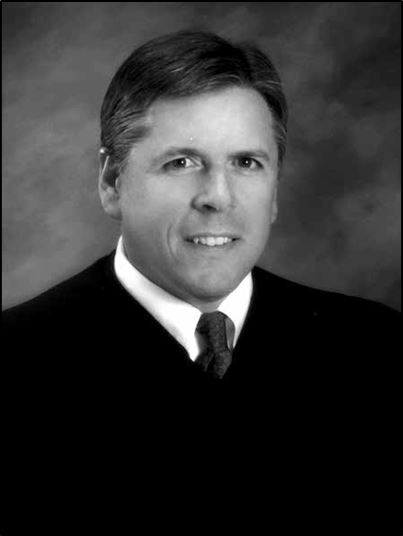
Daniel J. Crothers
Justice of the Supreme Court
Appointed: 2005 - Present
Justice Daniel J. Crothers was born in January 1957 in Fargo, North Dakota. He grew up in West Fargo, American Samoa, and Albuquerque, New Mexico. He received his undergraduate degree from the University of North Dakota in 1979 and his law degree from the University of North Dakota School of Law in 1982. After law school, he clerked for the New Mexico Court of Appeals and worked in a Santa Fe law firm. He moved back to North Dakota, practicing law in several law firms until being appointed to the North Dakota Supreme Court in June 2005.
Crothers was president of the State Bar Association of North Dakota from 2001-2002 and has served as a member and chair of several Bar Association and Court committees relating to lawyer and judicial ethics and professional conduct. He currently chairs the North Dakota Court Technology Committee, the Court Services Administration Committee, and the Judicial Branch Education Commission. He is a member of the ABA Standing Committee on Ethics and Professional Responsibility. He is past-chair of the Policy Implementation Committee at the ABA Center for Professional Responsibility and the ABA Standing Committee on Client Protection, and is a past member of the ABA’s Cybersecurity Task Force.
Crothers is a regular presenter of legal and judicial educational programs throughout the United States and its territories, and is an adjunct faculty member of the National Judicial College in Reno, Nevada. He was elected to the Supreme Court in November 2008 to fill an unexpired four-year term and elected in November 2012 to a full ten-year term. He and his wife have two children.
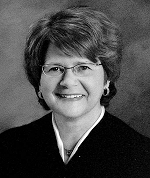
Carol Ronning Kapsner
Justice of the Supreme Court/Surrogate Judge
Appointed: 1998 - 2017
Justice Carol Ronning Kapsner was born November 25, 1947, in Bismarck, North Dakota, and raised in Underwood and Bismarck. She received a Bachelor of Arts degree in English literature from the College of St. Catherine in St. Paul, Minnesota, in 1969; Phi Beta Kappa; studied 17th-century English literature at Oxford University; and, as a Woodrow Wilson fellow and Indiana University fellow, received a Master of Arts degree in English literature from Indiana University in 1971. She received her Juris Doctor degree from the University of Colorado School of Law in Boulder, Colorado, in 1977. She started the law firm of Kapsner and Kapsner in Bismarck in 1977 and remained in private practice until 1998. In 1980, she served as president of the Burleigh County Bar Association, and from 1993-1995, served on the Board of Governors of the State Bar Association of North Dakota. She was appointed by the Bar Association to serve on the Judicial Conference from 1988 to 1996. In October 1998, Governor Edward T. Schafer appointed Justice Kapsner to fill the vacancy created by the retirement of Justice Herbert L. Meschke. In 2000 and 2010, she was elected to 10-year terms. She chairs the Judicial Planning Committee, co-chairs the Commission to Study Racial and Ethnic Bias in the Courts, and serves on the Personnel Policy Board. She served on the Judicial Education Commission, the Committee on Tribal and State Court Affairs, and chaired the Court Services Administration Committee. She served on the ABA Standards Review Committee. Her husband, John C. Kapsner, is a lawyer. They have two children. Justice Kapsner retired July 31, 2017, having served 18 years, 9 months, and 2 days on the Bench.
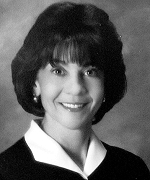
Mary Muehlen Maring
Justice of the Supreme Court
Appointed: 1996 - 2013
Mary Muehlen Maring was born and raised in Devils Lake, North Dakota. She received her B.A. degree in Political Science and German from Moorhead State University in 1972. Justice Maring graduated in 1975 from the University of North Dakota School of Law with a Juris Doctorate degree. After law school, she worked as a law clerk for the Honorable Bruce Stone, Hennepin County District Court, Minnesota. In 1976, she entered the private practice of law and spent 20 years practicing law in North Dakota and Minnesota state and federal courts. During her practice of law, she handled cases in many areas of civil litigation. She is certified as a Civil Trial Specialist by the Minnesota State Bar Association. She is a member of the International Society of Barristers. She has served in leadership positions in both the North Dakota and Minnesota Bar Associations, including president of the Clay County Minnesota Bar, president of the East Central Judicial District Bar Association, president of North Dakota Trial Lawyers Association, and a member of the Board of Governors of the State Bar Association of North Dakota. She has served on numerous committees to study and improve the system of justice. On March 1, 1996, she was appointed by Governor Edward Schafer to the North Dakota Supreme Court to fill the vacancy created by Justice Beryl Levine's retirement. On November 5, 1996, she was elected to complete that term, and in November 1998 and 2008, she was elected to ten-year terms as a justice on the North Dakota Supreme Court. She has served as chair of the North Dakota Judicial Conference, the Gender Fairness Implementation Committee, the study implementation committee of the Juvenile Drug Courts in North Dakota, the Joint Procedure Committee, the Judicial Education Commission, and the Juvenile Drug Court Advisory Committee. She was a member of the Juvenile Policy Board, the Commission to Study Racial and Ethnic Bias in the Courts, the Administrative Council, and the Alternatives to Incarceration Interim Legislative Committee. She retired as a Supreme Court Justice effective Dec. 31, 2013, after serving 17 years and 9 months. In 2018, she was presented with the Sioux Award, the highest honor given by the University of North Dakota Alumni Association and Foundation. She resides in Scottsdale, Arizona.
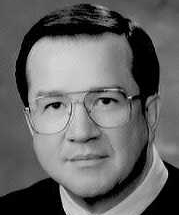
William A. Neumann
Justice of the Supreme Court/Surrogate Judge
Elected: 1993 - 2005
Justice William A. "Bill" Neumann was born February 11, 1944, in Minot, North Dakota. He grew up in Bowbells and in Crosby, North Dakota, graduating from Crosby High School in 1961 and from the University of North Dakota in 1965. He graduated from Stanford Law School in 1968 and returned to North Dakota, going into private practice at Williston and then Bottineau. In October 1979, he was appointed to the District Court and was elected in 1980 and reelected in 1984 and 1990. From 1981 through 1987, Neumann served on the North Dakota Judicial Conduct Commission. He was the first trial judge to chair the North Dakota Judicial Conference, from 1987 to 1989. In November 1992, he was elected to a ten-year term on the North Dakota Supreme Court, beginning January 1, 1993. Reelected in 2002. Justice Neumann has been a member of the Board of Directors of American Judicature Society since 1998. He and his wife Jackie have two children. Justice Neumann served 12 years and 2 1/2 months before resigning from the Court on March 14, 2005. After leaving the Court, he served as Executive Director of the State Bar Association of North Dakota until 2013. He is currently a Surrogate Judge and resides in Bismarck.
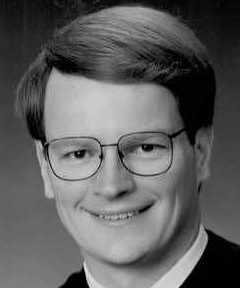
Dale V. Sandstrom
Justice of the Supreme Court/Surrogate Judge
Elected: 1992 - 2016
Dale V. Sandstrom is a fifth-generation North Dakotan. He was born March 9, 1950, in Grand Forks, North Dakota, and attended the Fargo school system. He received his B.A. degree from North Dakota State University and in 1975 received his juris doctor degree from the University of North Dakota School of Law. He worked for the United States Senate under Senator Milton R. Young; served on the staff of the North Dakota Criminal Justice Commission; and served as an Assistant Attorney General for six years, heading the Consumer Fraud and Antitrust Division. In 1981, Governor Allen I. Olson named him State Securities Commissioner. Effective May 5, 1983, he was appointed to the Public Service Commission. In 1984 and 1990 he was elected to six-year terms on the Commission, and he served two terms as President of the Commission. In 1992, he was elected Justice of the Supreme Court, assuming office on December 31, 1992. He was reelected to ten-year terms in 1996 and in 2006. Justice Sandstrom is a graduate of the National Judicial College. He chaired the Joint Procedure Committee and the North Dakota Advisory Commission on Cameras in the Courtroom, and was a member of the Joint Committee on Attorney Standards. He is past chair of the Court Technology Committee, the North Dakota Judicial Conference, and the North Dakota Judges Association. He is married to District Judge Gail Hagerty. They have three children. Justice Sandstrom did not seek reelection and retired on December 31, 2016, having served 24 years and one day on the Supreme Court, the seventh longest serving Justice since statehood.
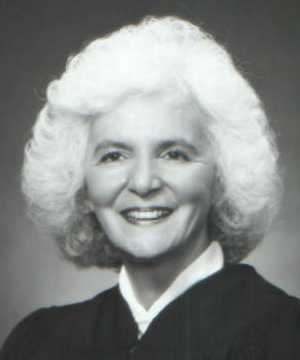
Beryl J. Levine
Justice of the Supreme Court
Appointed: 1985 - 1996
Justice Levine was born November 9, 1935, in Winnipeg, Manitoba. She attended the University of Manitoba from 1952 to 1955 and later obtained a B.A. degree in 1964 from that institution. She moved to the United States in 1955. She received a law degree from the University of North Dakota in 1974. Upon graduation from law school, she joined a law firm in Fargo and practiced with that firm for ten years. On January 17, 1985, she was appointed to the North Dakota Supreme Court by Governor George A. Sinner, becoming the first woman ever afforded that honor and privilege in North Dakota. She was elected to serve the remainder of the unexpired term in 1986, and on November 8, 1988, was elected to a ten-year term. Justice Levine chaired the Judicial Planning Committee, which established a Commission on Gender Fairness in the Courts and Legal Profession. She was awarded the Margaret Brent Award given by the American Bar Association Commission on Women in the Profession and the Sioux Award, the highest honor given by the University of North Dakota Alumni Association and Foundation. Justice Levine served 11 years and one month before resigning from the Court on March 1, 1996. She died June 4, 2022, in San Mateo, California.
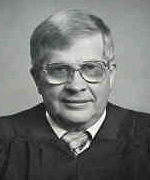
Herbert L. Meschke
Justice of the Supreme Court
Appointed: 1985 - 1998
Justice Meschke was born March 18, 1928, and raised on a small ranch north of Medora, North Dakota. He received his high school education in Belfield, North Dakota, and attended Jamestown College, where he obtained a B.A. degree in Economics in 1950. He attended the University of Michigan and received a juris doctor degree in 1953. Admitted to the North Dakota Bar in 1953, Justice Meschke served as law clerk to United States District Judge Vogel at Fargo from 1953 to 1954. In 1954 he joined a law firm in Minot and practiced with that firm until 1985. He served in the North Dakota House of Representatives from 1965 to 1966 and in the Senate from 1967 to 1970 and also served as Senate Minority Leader. He was appointed to the North Dakota Supreme Court by Governor George A. Sinner in January 1985 and elected to a four-year term in 1986. He was reelected to a ten-year term in November of 1990. Justice Meschke retired on September 30, 1998, after serving 13 years and eight months on the Bench. Following his retirement from the Court, he returned to Minot, North Dakota, and served as of counsel to Pringle and Herigstad, P.C. He died May 19, 2017 in Minot, North Dakota.
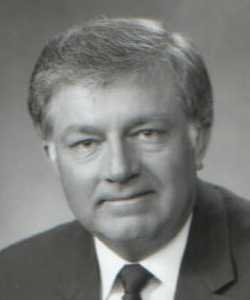
Herman Fredrick "Sparky" Gierke III
Justice of the Supreme Court
Appointed: 1983 - 1991
Justice Gierke was born in Williston, North Dakota, on March 13, 1943. He attended the University of North Dakota and received a B.A. degree in 1964 and a juris doctor degree from the University of North Dakota School of Law in 1966. He was admitted to the North Dakota Bar in 1966. He attended Judge Advocate General's School of the Army at the University of Virginia in 1967. He served as a Captain in the Judge Advocate General's Corps of the Army from May 1967 to April 1971. During the first two and one-half years of that time, he served as a legal assistance officer, with duties similar to those of a general office practice, and served in the military justice section, prosecuting and defending before courts-martial. From December 1969 to December 1970, he served as a trial judge in over 500 court martials in the Republic of Vietnam. Upon return from Vietnam, he served as a military judge at Fort Carson, Colorado, until release from active duty in April 1971. Upon his return to North Dakota, he practiced law for 12 years in Watford City. During that time, he served as McKenzie County State's Attorney from 1974 to 1982 and City Attorney for Watford City from 1974 to September 1983. He served as President of the State Bar Association of North Dakota in 1982-83. In 1984, he received the Governor's Award for outstanding service to the state from Governor Olson. He served as State Commander of the North Dakota American Legion from 1983 to 1984, and was appointed State Judge Advocate of the North Dakota American Legion. On August 28, 1985, he was elected National Vice Commander of the American Legion, and on September 8, 1988, was elected National Commander of the American Legion. On September 2, 1983, Governor Allen I. Olson appointed him to the North Dakota Supreme Court to fill the remainder of Justice Paulson's term. He was elected to complete that term in November 1984. In November 1986, Justice Gierke was elected to a ten-year term. After serving on the Court for eight years, Justice Gierke resigned November 20, 1991, after his appointment by President George H.W. Bush to the United States Court of Appeals for the Armed Forces (previously the Court of Military Appeals) in Washington, D.C. He served as Chief Judge of that court from 2006-2008, and then took senior status. He died August 7, 2016, in Bismarck, North Dakota.
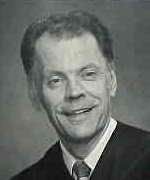
Gerald W. VandeWalle
Chief Justice/Justice of the Supreme Court
Appointed: 1978 - 2023
Justice VandeWalle was born on August 15, 1933, and raised in Noonan, North Dakota. He attended the University of North Dakota and in 1955 received a bachelor of science degree in Commerce from the School of Business. In 1958 he received a juris doctor degree magna cum laude from the University of North Dakota School of Law.
He was admitted to the State Bar of North Dakota in July 1958 and accepted an appointment as Special Assistant Attorney General. In January 1975 he was appointed First Assistant Attorney General. During his twenty years in the Attorney General's office, Justice VandeWalle held several portfolios, including the education portfolio for elementary, secondary, and higher education, for most of that time; the North Dakota Industrial Commission oil and gas portfolio; and the State Retirement System portfolio.
On August 15, 1978, he was appointed to the Supreme Court. In November 1978 he was elected to serve an unexpired term, and was reelected to ten-year terms in 1984, 1994, 2004 and 2014. From July 1985 to July 1987, he served as the first chair of the North Dakota Judicial Conference.
He is a past co-chair of the ABA Bar Admissions Committee and past chair of the Federal-State Tribal Relations Committee of the Conference of Chief Justices. Justice VandeWalle is past chair of the Council of the Section of Legal Education and Admissions to the Bar of the American Bar Association, past President of the Conference of Chief Justices, past chair of the National Center for State Courts, and past chair of the National Center for State Court's Research Advisory Council.
Justice VandeWalle was elected Chief Justice effective January l, 1993 to December 31, 2019; and reelected to successive five-year terms as Chief Justice effective 1995, 2000, 2005, 2010, and 2015.

Paul M. Sand
Justice of the Supreme Court
Elected: 1975 - 1984
Justice Sand was born in Balta, North Dakota, on October 21, 1914. He attended the University of North Dakota and graduated from the law school in 1941 with an LL.B., which was later converted into a juris doctor degree. He was admitted to the North Dakota Bar in 1941 shortly after graduation. He was inducted into the Army in the fall of 1941 as a private. One year later, he graduated from OCS as a Second Lieutenant and was assigned to division headquarters; subsequently, he was assigned to a corps headquarters. He served in the European Theatre while in the military service. He performed duties in various positions of the military justice system, such as trial judge advocate, defense counsel, member of general court, law member of general court, and president of special court. He was also assistant staff judge advocate of the United States Berlin District. He attended the London Law School Society while he was in the service. Shortly after the cessation of hostilities in the European Theatre, he began serving with the War Crimes Commission by commanding U.S. investigation teams attached to the British Army of the Rhine. In the spring of 1947, he was separated from the military service as a lieutenant colonel. After a brief interlude of recreation, he began a private practice in Rugby. He served as Assistant Attorney General from 1949 to 1963, when he was appointed First Assistant Attorney General. He was elected to the Supreme Court in 1974. Justice Sand died in office on December 8, 1984, at age 70, after serving nine years and 11 months on the Bench.
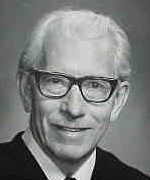
Vernon R. Pederson
Justice of the Supreme Court
Elected: 1975 - 1985
Justice Pederson was born September 11, 1919, on a farm in Ward County near Deering, North Dakota. He attended Minot State Teacher's College for two years. After World War II, he received B.S.C., LL.B., and J.D. degrees at the University of North Dakota. In 1949, he began to practice law in Minot and served as Minot City Justice for a time. For two years, 1951-52, he served in Fargo as an Office of Price Stabilization Special Agent-Attorney. On June 15, 1953, he was named a Special Assistant Attorney General for the State Highway Department and the State Game and Fish Department of North Dakota. From 1966 to 1972 he served on the original State Employee Retirement Board (PERS). He was the chairman of the first State Deferred Compensation Committee from 1972 to 1975. In 1974 he was elected to the Supreme Court and reelected in 1980. In 1975 he served the Supreme Court as chairman of the Management Information System, which designed the original computerization of court records in North Dakota. He was also chairman of the Supreme Court Personnel Advisory Board from 1982 to 1984. He represented the judiciary as a director of the North Dakota Community Foundation from 1976 to 1983. Justice Pederson was the first chairman of the Judicial Planning Committee, which was organized in 1976. Justice Pederson retired on January 7, 1985, after ten continuous years on the Bench. He served as a Surrogate Judge of the Supreme Court, 1985-1999. His wife Evelyn died in 2007. Justice Pederson died February 26, 2017 at Lakeville, Minn.
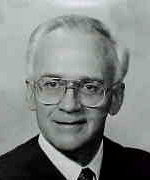
J. Philip Johnson
Justice of the Supreme Court
Appointed: 1974 - 1993
Justice Johnson was born in Minot, North Dakota, on March 28, 1938. He attended Minot State College and transferred to the University of North Dakota at Grand Forks, where he received a bachelor of philosophy degree in 1960. He received a juris doctor degree from the University of North Dakota School of Law in 1962. Following admission to the Bar, he was admitted to the United States Army Judge Advocate General's Corps. After three years of active duty, including a tour in Washington, D.C., handling court martial appeals, he returned to North Dakota. He then joined a law firm in Fargo for several years and also served as Assistant State's Attorney for Cass County. In June 1974, Justice Johnson was appointed to the Supreme Court to fill the seat vacated by Justice Teigen. He was defeated in the election for the balance of the term in 1974 and left the Court to return to private practice in Fargo on January 9, 1975, after serving seven months. After the resignation of Justice H. F. Gierke III, Governor George Sinner appointed Johnson to the Court on February 11, 1992. He served until January 1, 1993, after an unsuccessful election bid to fill out the remaining term. Justice Johnson returned to private practice in the Fargo law firm of Wold Johnson, P.C.
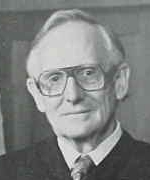
Robert Vogel
Justice of the Supreme Court
Appointed: 1973 - 1978
Justice Vogel was born in Coleharbor, North Dakota, on December 6, 1918. He received his B.S. degree from the University of North Dakota in 1939 and his law degree from Minneapolis-Minnesota College of Law in 1942. He was admitted to the Minnesota Bar in 1942 and the North Dakota Bar in 1943. He practiced law in Garrison from 1943 to 1954. During that time, he served as McLean County State's Attorney for five years. From 1954 to 1961 he served as United States Attorney in Fargo, and practiced in Mandan from 1961 to 1973. In 1973 he was appointed to the Supreme Court, and in 1974 he was elected to finish Justice Strutz's ten-year term. Justice Vogel served five years and two and one-half months before resigning from the Supreme Court. After his resignation, he joined the staff of the University of North Dakota School of Law as a professor and established the Vogel Law Firm in Grand Forks. Justice Vogel died January 28, 2005, at age 86.
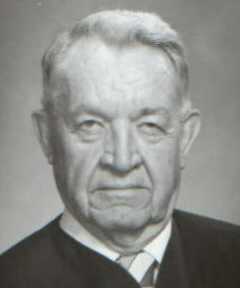
William L. Paulson
Justice of the Supreme Court
Elected: 1967 - 1983
Born September 3, 1913, at Valley City, North Dakota, son of Alfred P. and Inga G. Paulson. Graduate of Valley City High School, 1931; B.A., Valley City State College, 1935; L.L.B., University of North Dakota, 1937, and J.D. Practiced in Valley City, 1937-1966; Barnes County State's Attorney, 1941-1950 and 1959-1966. Elected to 10-year term as Associate Justice of Supreme Court, 1966. Reelected 1976. Resigned September 5, 1983. Surrogate Judge, 1983-2000. Member, Judicature Society; president, State's Attorney Association, 1964; director, National District Attorneys Association, 1963-65. Chancellor of Episcopal Church of North Dakota, 1965; District Vice-President, U.S. Jaycees, 1945-46; past director, Valley City Chamber of Commerce; UND Sioux Award recipient, 1973. Judge on National Awards Jury of Freedoms Foundation at Valley Forge, Pennsylvania, 1969, 1971, 1977; Judge, American Legion Oratorical Contest, 1970-72. Member, Elks; past chancellor, Knights of Pythias; Eagles; Masonic Orders; Shrine. Married Jane E. (Betty) Graves in 1938. Two children: John T. and Mary (Mrs. Mikal) Simonson. Died June 16, 2000.
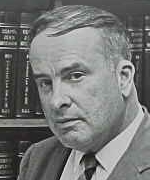
William S. Murray
Justice of the Supreme Court
Appointed: 1966 - 1966
Justice Murray was born in Bismarck, North Dakota, on December 26, 1916, and received his early education in the Mott public schools. He attended the University of North Dakota and received his B.A. degree in 1937 and his law degree in 1939. After admission to the Bar he practiced law in Bismarck. Justice Murray served in World War II from April 1, 1941, to February 6, 1946, and in the Korean War from November 1, 1950, to March 5, 1953. During 1947 he briefly worked for the Central Intelligence Agency in Washington, D.C. In 1951 he graduated from the Army Language School located in Monterey, California. He was a member of the North Dakota House of Representatives in 1949 and 1950. He served as Assistant Attorney General in 1953 and as a Special Assistant Attorney General from 1957 to 1964. On April 1, 1966, at age 49, he was appointed to the Supreme Court to succeed Justice Burke who had died in office. He was defeated in his attempt to be elected to Justice Burke's unexpired term and left the Court after serving a period of nine months. After leaving the court, Justice Murray served as General Counsel for the Montana-Dakota Utilities Corporation from 1967 to 1976. He is the author of the novel, "Song of the Dusty Stars," published in 1985. Justice Murray died on November 30, 1998, at age 81.
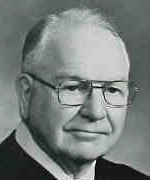
Harvey B. Knudson
Justice of the Supreme Court
Elected: 1965 - 1975
Justice Knudson was born on June 26, 1903, in Finley, North Dakota. He attended elementary and high school in Finley. He received his law degree from the University of North Dakota School of Law in 1931 and started a practice in Finley, where he remained until 1937. In 1937 he moved to Mayville, where he practiced until being elected to the Supreme Court. Justice Knudson served in the House of Representatives from 1937 to 1939 and in the State Senate from 1951 to 1959. In 1964, at age 61, Justice Knudson was elected to the Supreme Court and served ten years before his retirement in 1975. Justice Knudson died on June 29, 1978, at age 75.
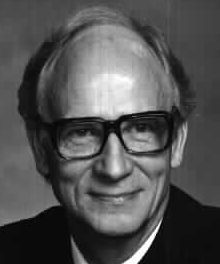
Ralph J. Erickstad
Justice of the Supreme Court
Elected: 1963 - 1992
Justice Erickstad was born on a farm near Starkweather, North Dakota, on August 15, 1922. He received his early education in the Starkweather public schools and attended the University of North Dakota for a few years before transferring to the University of Minnesota. He received a bachelor's degree and his law degree from the University of Minnesota. He began a law practice in Devils Lake in 1949 and continued his practice until his election to the Supreme Court. While practicing in Devils Lake, he served as Police Magistrate and served four years as Ramsey County State's Attorney. He also served in the North Dakota Senate during the 1957, 1959, and 1961 sessions. He was elected to the Supreme Court in 1962 at age 40. Justice Erickstad was a member of the task force on "The Public Image of the Courts," 1978 Williamsburg Conference. He served on the National Conference of Chief Justices—on the Executive Council in 1977-78 and 1980-82, as First-Vice Chairman in 1982-83, and as President in 1983-84—and the National Center for State Courts, as President in 1983-84. On July 2, 1987, President Reagan appointed him to the Board of Directors of the State Justice Institute for a term that expired on September 17, 1989. He received the North Dakota National Leadership Award of Excellence from Governor Sinner in 1987, the Distinguished Service Award from the State Bar Association in 1988, and the National Center for State Court's Distinguished Service Award in 1989. After serving on the Court for 30 years, nearly 20 of them as Chief Justice, Erickstad retired December 31, 1992. Upon retirement, he was appointed Surrogate Judge. He resided in Bismarck until his death on July 12, 2001, at age 78. He is survived by his wife Lois and two children.
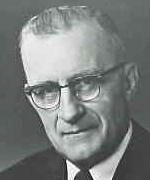
Alvin C. Strutz
Justice of the Supreme Court
Appointed: 1959 - 1973
Justice Strutz was born on May 5, 1903, in Milbank, South Dakota. He attended elementary and secondary schools in Jamestown and graduated in 1925 with a bachelor of arts degree from Jamestown College. He taught high school for two years and then entered the University of North Dakota School of Law in the fall of 1927 and graduated with a juris doctor degree in 1930. Justice Strutz practiced law in Jamestown from 1930 until April 1933. He then moved to Bismarck and practiced until he was appointed Attorney General in December of 1937. As Attorney General, he replaced P. O. Sathre who had been appointed to the Supreme Court. He was elected Attorney General in 1938 and reelected in 1940 and 1942. He was an unsuccessful candidate for Governor in 1944. After leaving the Attorney General's office, he practiced law in Bismarck until he was appointed to replace Justice Johnson on the Supreme Court. His appointment became effective on April 11, 1959, and he was 54 years of age when he assumed office. He was elected in 1960 to the eight remaining years of Justice Johnson's term and was reelected in 1968. Justice Strutz served on the Court for 14 years and one month. He died on June 16, 1973, at age 70.
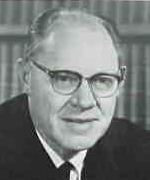
Obert C. Teigen
Justice of the Supreme Court
Appointed: 1959 - 1974
Justice Teigen was born near Tolna, North Dakota, on September 27, 1908. He graduated from Edmore High School in 1927. He then attended the University of North Dakota and received a bachelor of science degree in 1931 and a law degree in 1934. He was admitted to the North Dakota Bar in 1934. With the exception of a two-year period as a special agent for the F.B.I., he practiced law in Devils Lake until 1954. He was also Ramsey County State's Attorney from 1937 to 1943 and from 1945 to 1946. He assumed the position of District Judge for the Second Judicial District in 1954 and served in that capacity until he was appointed to the Supreme Court to replace Justice Grimson. He assumed office on January 13, 1959, at age 50. He was elected to a ten-year term in 1960 and reelected in 1970. He resigned in July 1974 after 15 years and six months of continuous years on the Bench. Following his retirement from the Court, Justice Teigen accepted an appointment as an Administrative Judge with the Social Security Administration in 1975. His terminal illness forced his resignation from the Social Security Administration in February 1978. Justice Teigen died on May 26, 1978, at age 69.
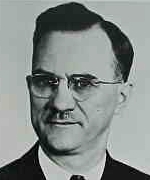
Nels Johnson
Justice of the Supreme Court
Appointed: 1954 - 1958
Justice Johnson was born in Akrens, Iceland, on April 30, 1896. He came to the United States with his parents in 1900. He received his early education in the McHenry public schools and graduated from Bottineau High School in 1917. He enlisted in the Army in the fall of 1917 and served until May 1919. He received a bachelor of arts degree from the University of North Dakota in 1924 and his law degree in 1926. He was admitted to the North Dakota Bar in 1926 and started practice in McHenry County. He served as McHenry County State's Attorney for ten years and was elected North Dakota Attorney General in 1944 and 1946. He resigned as Attorney General on September 1, 1948, and entered private practice in Bismarck. He was appointed to the Supreme Court on April 1, 1954, to fill the position left vacant by the death of Justice Christianson. He was 57 years of age when he assumed office and, in the 1954 general election, was elected to serve out Justice Christianson's term. He was reelected to a ten-year term in 1958 but died at age 62 on December 2, 1958, after serving approximately four years and eight months.
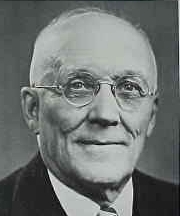
Gudmunder Grimson
Justice of the Supreme Court
Appointed: 1949 - 1958
Justice Grimson was born in Iceland on November 20, 1878, and came with his family to the Dakota Territory in 1882 and located in Milton. He attended the Milton public schools and then taught there for a time before enrolling at the University of North Dakota in 1898. As he earned his own way through college, he attended the University intermittently until receiving his B.A. degree in 1904. He earned a master of arts degree in 1905 and was a Fellow of the University of Chicago in 1905 and 1906. He also received his law degree from the University of North Dakota in 1906. He received honorary doctor of laws degrees from the University of Iceland in 1950 and the University of North Dakota in 1939. He began his law practice in Munich, North Dakota, in 1906 and was the Editor-Publisher of the Munich Herald from 1908 to 1912. He served as State's Attorney for Cavalier County from 1910 to 1924. He became involved in the investigation of the death of a young North Dakota man in Florida and, thus, served as a Special Assistant Attorney General in the Florida Tabert-Whipping Box investigation and prosecution during the period between 1923 to 1925. He was elected judge of the Second Judicial District in 1926 and served until, at age 70, he was appointed to the Supreme Court on September 19, 1949, to succeed the retired Justice Burr. In the 1950 general election he chose to run for Justice Nuessle's position, rather than running for Justice Burr's remaining two-year term. He was elected to a ten-year term. He resigned on December 31, 1958, after serving on the Court for nine years and three months. Justice Grimson died on June 22, 1965, at age 86.
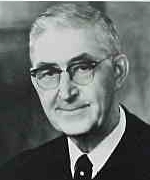
Thomas J. Burke
Justice of the Supreme Court
Elected: 1939 - 1966
Justice Burke was born in Rolla, North Dakota, on October 24, 1896. He was educated in the public schools of Rolla, Devils Lake and Washington, D.C. He served in the Navy for a time during World War I and, upon being discharged, continued his education and received his B.A. degree from Harvard University. He received his legal training studying under Usher L. Burdick and his father, John Burke. Upon being admitted to the North Dakota Bar, he started a practice in Fargo and in 1929 was named an Assistant Attorney General and served in that capacity until 1933. He served in the State Legislature in 1935. In 1938 Justice Burke defeated P. O. Sathre and was elected to the Supreme Court to fill his father's unexpired term. He was 42 years old when he assumed office and was reelected in 1946 and 1956. He died in office at age 69 on March 20, 1966, after serving approximately 27 years and three months on the Court.
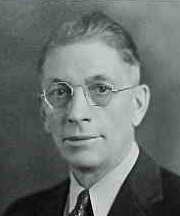
Peter. O. (P.O.) Sathre
Justice of the Supreme Court
Elected: 1937 - 1962
Justice Sathre was born on February 7, 1876, in Adams, Minnesota. He moved to Steele County, Dakota Territory, with his parents in 1884. His early education was in the public schools of Steele and Griggs Counties, and in 1910 he received his law degree from the University of North Dakota. He practiced at Finley, North Dakota, and served as Steele County State's Attorney for 13 years. He was also a one term member of the State House of Representatives and a three term member of the State Senate. He was appointed Assistant United States Attorney in 1932 but resigned in April of 1933 to accept an appointment as First Assistant Attorney General for North Dakota. He then became Attorney General upon the resignation of A. J. Gronna and was elected as Attorney General in 1934 and reelected in 1936. He resigned on December 1, 1937, to accept an appointment to the Supreme Court when a vacancy occurred due to the death of Justice Burke. Justice Sathre assumed office at age 61. He was defeated in 1938 and left the Court December 31, 1938, after serving one year and one month. He then served as an Assistant Attorney General under Attorneys General Strutz, Nels Johnson and Wallace Warner. He then became one of two Supreme Court Justices to serve on the Court at two different intervals when, at age 74, he was elected in 1950 to fill the unexpired term of Justice Burr. He was reelected in 1952 and retired in 1962 after 12 continuous years on the Bench. He served a total of 13 years and one month on the Court. Justice Sathre died on January 23, 1968, at age 91.

James Morris
Justice of the Supreme Court
Elected: 1935 - 1964
Justice Morris was born in Bordulac, North Dakota, on January 2, 1893. He received his high school and college education in Cincinnati and subsequently received his law degree from the University of Cincinnati Law School. He practiced law in Carrington, North Dakota, until the outbreak of World War I. After serving in the war, he returned to Carrington, where he resumed his practice, and served as City Attorney for a time and as Foster County State's Attorney for two terms. In the summer of 1928, he was appointed Assistant Attorney General and, in November of 1928, was elected Attorney General and served in that position until 1932. He then practiced law in Jamestown in 1933 and 1934. He ran for election to the Supreme Court in 1934 and defeated Justice Moellring to win a ten-year term beginning in 1935. He was 41 years of age when he assumed office and was reelected in 1944 and 1954. He took approximately a year's leave of absence to serve as a trial judge for the War Crimes Tribunal in Germany after World War II. Justice Morris served the Court for almost 30 years. After his retirement from the Bench, he served several years as Supreme Court Commissioner. Justice Morris resided in Bismarck until his death on July 20, 1980, at age 87.
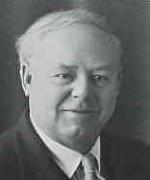
George Moellring
Justice of the Supreme Court
Appointed: 1933 - 1934
Justice Moellring was born in Quincy, Illinois, on November 14, 1878. He received his common education in the Quincy schools and studied law at Chaddock College of Law in Quincy. He completed his study at age 19; since he was too young to be admitted to the Bar, he taught school for one year and then enrolled in post graduate study of law at Highland Park College in Des Moines, Iowa. In 1901 he received a master of laws degree and was admitted to the Iowa Bar. He moved to North Dakota in 1902 and was admitted to the Bar. He practiced in Langdon from 1902 until 1905 and then moved his practice to Ray, North Dakota, in Williams County. Moellring authored a novel called "The Neutrals Portion" in 1916 under the pen name of Elwin Lorraine. In 1920 he was elected Judge of the District Court for the Fifth Judicial District and was reelected in 1924, 1928 and 1932. He resigned from the District Bench after 13 years of service to accept an appointment to the Supreme Court. On December 1, 1933, at age 55, he was appointed to the Court to fill the vacancy caused by the resignation of Justice Birdzell. He served one year and one month and was defeated in the election of 1934. He served as Assistant Attorney General for a short time after the 1934 election. Justice Moellring died on May 31, 1935, at age 56.
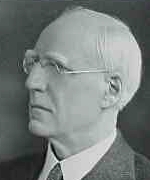
Alexander Burr
Justice of the Supreme Court
Appointed: 1926 - 1949
Justice Burr was born in Pitrodie, Perthshire, Scotland, on February 25, 1871. He lived with his parents in Trinidad and Ontario until coming with them to the Dakota Territory in September 1883. He pursued his higher education at the University of Michigan and received a LL.B. degree and a LL.M. degree in 1894. He later received an honorary doctor of laws degree from the University of North Dakota. He was admitted to the North Dakota Bar in 1894 and was elected State's Attorney of Bottineau County that same year. He was reelected State's Attorney in 1900 and 1902. In 1908 he was elected as the Ninth Judicial District Judge and served in that capacity until 1919, when the judicial districts were revised and he became Judge of the Second Judicial District. On September 1, 1926, Justice Burr was appointed to the Supreme Court by Governor Sorlie to succeed Justice Johnson. At the time of his appointment, he was 55 years of age. He was elected to a full term in 1928 and was reelected in 1934 and 1942. He retired from the Supreme Court on September 15, 1949, due to disability, after serving approximately 22 years, ten and one-half months. Justice Burr died on February 8, 1951, at age 79.
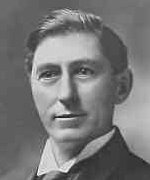
John Burke
Justice of the Supreme Court
Elected: 1925 - 1937
Justice Burke was born February 25, 1859, in Sigourney, Iowa. He was educated in Iowa and in 1886 obtained his law degree from Iowa State University. From 1886 to 1888 he practiced with his brother in Des Moines and by himself in Henning, Minnesota. He came to the Dakota Territory in August 1888, and worked for a time as a farm hand in Traill County. He then moved to St. John, Rolette County, where he taught school, edited the local paper, and practiced law. He moved to Rolla when it became the county seat, served as Rolette County Judge from 1889 to 1891, and practiced law until September 1902. A member of the State House of Representatives from 1893 to 1895, he unsuccessfully ran for State Attorney General in 1894, U.S. Congress in 1896, and District Judge in 1900. In 1902 he moved to Devils Lake and practiced law until he was elected Governor in 1906 and reelected in 1908 and 1910. After retiring as Governor, he was appointed Treasurer of the United States by President Wilson and served from 1913 until March 1921. He then joined a stockbroker firm in New York City and shortly thereafter his firm, and about forty others, went bankrupt. He returned to Fargo and practiced law with his son, Thomas, until, in 1924, he was elected to the Supreme Court at age 65 and reelected in 1930 and 1936. In 1936, he received an honorary doctor of laws degree from the University of North Dakota. Justice Burke died in office at age 78, on May 14, 1937, after serving on the Bench approximately 12 years, four and one-half months.
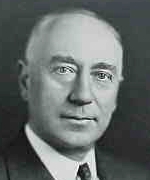
Sveinbjorn Johnson
Justice of the Supreme Court
Elected: 1923 - 1926
Justice Johnson was born in Iceland on July 10, 1883, and came to Dakota Territory with his parents in 1887. After receiving his early education in this state's public schools, he attended the University of North Dakota where he received a bachelor of arts degree in 1906, a master of arts degree in 1907 and a law degree in 1908. He then undertook some special studies at the University of Wisconsin. In 1911 he opened a law office in Cavalier and in 1913 moved to Grand Forks. In addition to his practice, he lectured in Political Science and Law at the University of North Dakota. Johnson was elected Attorney General in the 1921 election which was brought about by the recall of William Lemke. In 1922 he defeated Justice Robinson for a position on the Supreme Court and assumed office at age 39. After serving the Court for three years and eleven months, he resigned December 1, 1926, to become legal counsel and Professor of Law at the University of Illinois. He continued in those capacities until resigning on September 1, 1944. He was defeated in the 1944 election for the position of Illinois Attorney General. On January 1, 1945, he opened a law office in Chicago and remained in practice until his death at age 62 on March 16, 1946. In addition to his other accomplishments, Justice Johnson authored several books on law and history and received honorary Doctor of Laws degrees from the University of Iceland in 1930 and the University of North Dakota in 1937.
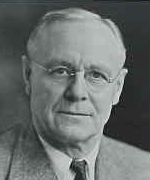
William Nuessle
Justice of the Supreme Court
Elected: 1923 - 1950
Justice Nuessle was born May 5, 1878, in North Boston, Erie County, New York. In 1886 he came with his parents to the Dakota Territory and settled on a farm near Emerado in Grand Forks County. He received his early education in the Grand Forks area public schools, and his higher education at the University of North Dakota, where he received his bachelor of arts degree in 1899, and his law degree in 1901. After being admitted to the Bar he opened an office in Goodrich, North Dakota. In 1904 he moved to Washburn and was elected State's Attorney for McLean County and served four years in that capacity. He was elected to the District Court Bench in 1912 and served the Sixth and Fourth Judicial Districts until his election to the Supreme Court in 1922 at age 44. He was reelected in 1928, 1934 and 1940. After serving 28 years, he retired at the expiration of his term on December 31, 1950. Justice Nuessle remained in Bismarck until his death, at age 80, on March 30, 1959.
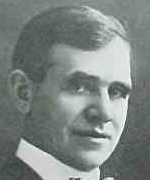
Harrison A. Bronson
Justice of the Supreme Court
Appointed: 1918 - 1924
Justice Bronson was born in Nunica, Michigan, on November 19, 1873, where he received his early schooling. He moved to North Dakota and received a bachelor of arts degree from the University of North Dakota in 1894; a master of arts degree in Latin from the University of North Dakota in 1895; and a law degree from the University of Minnesota in 1901. He was admitted to practice in Minnesota and North Dakota in 1901 and started a practice in East Grand Forks, Minnesota. Within a short time, he moved to Grand Forks where he practiced until 1917. During this period he served in the State Senate from 1913 to 1917, then in 1917 and part of 1918 he served as an Assistant Attorney General. He was elected to the Supreme Court in the 1918 general election at age 45; however, he was also appointed to fill the vacancy created after the resignation of Justice Bruce in December 1918. He retired from the Bench when his term expired on December 31, 1924, after serving six years and one month. He then became Chief Counsel for the State Mill and Elevator; in addition, he carried on a private practice, lectured at the University of North Dakota School of Law, and authored four books in various areas of property law. Justice Bronson died April 22, 1947, at age 73.
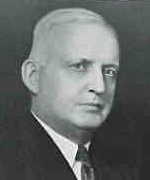
Luther E. Birdzell
Justice of the Supreme Court
Elected: 1917 - 1933
Justice Birdzell was born in St. Joseph, Illinois, on December 1, 1880. He received his elementary and secondary education in the Illinois school system. He received his law degree at the University of Illinois School of Law and practiced law in Chicago one year before coming to North Dakota. He taught at the University of North Dakota School of Law from 1904 until 1912. He left his teaching position to serve as North Dakota's first State Tax Commissioner from 1912 to 1914. He then returned to his teaching duties at the University until he defeated Justice Fisk for a position on the Supreme Court in the 1916 general election. Justice Birdzell assumed his position on the Court in January of 1917 at age 36 and was subsequently reelected in 1922 and 1928. After serving approximately 16 years and ten months on the Court, Justice Birdzell resigned on November 1, 1933, to assume the position of General Counsel for the Federal Deposit Insurance Corporation. During his career, he also served as Vice President and Senior Trust Officer of the Bank of America National Trust and Savings Association of San Francisco. Justice Birdzell died on February 23, 1973, at age 92.

James Robinson
Justice of the Supreme Court
Elected: 1917 - 1922
Justice Robinson was born in Michigan on May 11, 1843. He obtained his early education in Canada where he taught school for a short time. He enlisted in the Army and served during the Civil War. After being discharged, he started his formal education which culminated in his graduation from Michigan State University School of Law on March 5, 1868. He practiced law in Wisconsin until moving to Fargo, Dakota Territory, in 1883. While in Wisconsin, he served one term as District Attorney for Trempleau County. He practiced in Fargo until his election to the Supreme Court in 1916 at age 73. He served a six-year term but was defeated in a reelection attempt in 1922. During his term on the Bench he wrote a weekly letter for the newspapers concerning the work of the Supreme Court. He also authored a book in 1923 entitled "Wrongs and Remedies". After leaving the Bench he remained in Bismarck and practiced law until he was forced to retire due to health reasons. Justice Robinson entered a National Soldiers Home in Milwaukee in 1931 and remained there until his death on March 22, 1933, at age 89.

Richard Grace
Justice of the Supreme Court
Elected: 1917 - 1922
Justice Grace was born near Palmyra, Illinois, on November 8, 1868. He received his early education in country schools, however, when he was about 15 years of age his education was interrupted for several years when his father died. He then prepared himself with the preliminary requirements which allowed his admission to Bushnell College near Peoria, Illinois, which he attended for three years. In 1889, he then undertook the study of law in an office in Springfield, Illinois. He combined his law studies with teaching until 1893 when he moved to Morris, Minnesota, where he taught and continued his study in a Morris law office. He was admitted to the Minnesota Bar in 1895 and practiced in Morris for ten years. In 1905, he moved to Mohall, North Dakota, where he practiced until he defeated Justice Goss for election to the Supreme Court in 1916. Justice Grace was 48 years old when he assumed office. He retired from the Bench after six years and then opened an office in Bismarck where he practiced for two years. He then went to Sioux City, Iowa, for about a year. He returned to Minot and practiced for three years before returning to Mohall where he remained until his death at age 60 on February 9, 1929.
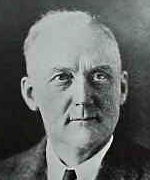
Adolph M. Christianson
Justice of the Supreme Court
Elected: 1915 - 1954
Justice Christianson was born in Brunmundalen, Norway, in 1877. He came to the United States with his parents in 1882. He spent his childhood days in Polk County, Minnesota, and received his early education in the Minnesota public schools. He was, for the most part, self-educated; but he attended the Law Department of the University of Tennessee and was admitted to the Bar in 1889. He moved to North Dakota in 1900 and was admitted to the North Dakota Bar on March 27th of that same year. Justice Christianson immediately opened an office in Towner, North Dakota, where he practiced until his election to the Supreme Court. During his practice in Towner he served as State's Attorney from 1901 until 1905. He was elected to the Supreme Court in 1914 at age 37. He was reelected to the Court in 1920, 1926, 1932, 1938 and 1948. Justice Christianson died in office at the age of 76 on February 11, 1954, after serving on the Court for 39 years and one month.

Andrew A. Bruce
Justice of the Supreme Court
Appointed: 1911 - 1918
Justice Bruce was born in Madras, India, on April 15, 1866, to Scottish parents. His father, a General in the British Army, was stationed in India at the time of his birth. He received his elementary education in England, and in 1881, at age 15, he was orphaned and came to the United States by himself. He worked as a farm laborer in Minnesota for a number of years and then entered the University of Wisconsin and received his law degree in 1892. He practiced for a short time in Wisconsin and Illinois and served on the legal staff of the Wisconsin Central Railway Company and the Illinois State Board of Factory Inspectors. In 1898, he discontinued the practice of law and began a teaching career at the University of Wisconsin School of Law. In 1902 he came to North Dakota to serve as Dean of the School of Law at Grand Forks. He served as Dean until October 31, 1911, when Governor Burke appointed him to fill the position on the Supreme Court left vacant when Justice Morgan resigned. He assumed office at age 45 and was elected to a full term in 1912. He resigned from the Court on December 1, 1918, after serving approximately seven years and one month, to reenter the teaching profession. He moved to Minnesota and taught at the University Law School from 1919 to 1922 and then accepted a position at Northwestern University Law School where he remained until his death at age 68 on December 6, 1934.
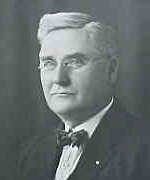
Edward T. Burke
Justice of the Supreme Court
Elected: 1911 - 1916
Justice Burke was born November 5, 1870, near Minneapolis, Minnesota. His parents moved to the Dakota Territory shortly after he was born. He received his early education in the North Dakota public schools. He attended the University of North Dakota for two years and then transferred to the University of Minnesota where he received his law degree. After being admitted to the North Dakota Bar, he started a practice in Valley City and served as Barnes County State's Attorney from 1901 to 1905. He was elected as Judge of the Fifth Judicial District and after serving one term he was reelected. However, in 1910 he resigned from that position when he defeated Justice Carmody in the general election for a position on the Supreme Court. Justice Burke assumed his position on the Bench at age 40 and served a six-year term before being defeated in 1916 in his attempt for reelection. He then practiced law in Bismarck until 1926 at which time he received an appointment as a Special Investigator for the Department of Justice. He served in that capacity until his death in Flossmoor, Illinois, on December 25, 1935, at age 65.
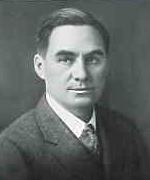
Evan B. Goss
Justice of the Supreme Court
Elected: 1911 - 1916
Justice Goss was born in Rockford, Michigan, on December 8, 1872. He received his early education in the Rockford school system. He then attended the University of Michigan and received his law degree in 1894 and a master's degree in 1895. He practiced in Grand Rapids for a short time prior to moving to Bottineau, North Dakota, where he opened a law office. He practiced in Bottineau for approximately nine years during which time he served as Bottineau County State's Attorney for two terms. He was elected Judge of the Eighth Judicial District in 1904 and then moved to Minot. He defeated Justice Ellsworth for a position on the Supreme Court in the 1910 election and assumed office at age 38. Justice Goss was defeated in his attempt for reelection in 1916 and returned to Minot to practice law, having served six years on the Bench. He continued his practice in Minot until his death at age 57 on March 23, 1930.
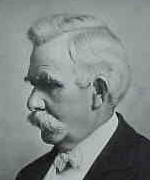
John Carmody
Justice of the Supreme Court
Appointed: 1909 - 1910
Justice Carmody was born January 6, 1854, in Granville, Milwaukee County, Wisconsin. He received his early education in the Wisconsin public schools. When he was 14 he moved with his parents to Waseca, Minnesota, where he received his high school education. He then taught school for several years and, subsequently, took up the study of law in an attorney's office in Waseca. Justice Carmody was admitted to the Bar in March 1880 after having pursued his studies for several years. He practiced law in Waseca until August 1885 at which time he moved to Hillsboro, Dakota Territory. While a resident of Hillsboro, he served one term as Mayor and 14 years as City Attorney. He also served one term as Traill County State's Attorney. Justice Carmody was appointed to the Supreme Court by Governor Burke on January 15, 1909, at age 55, pursuant to the constitutional change increasing the number of justices from three to five. He was defeated for the position in the 1910 election, and left the Bench after serving one year, eleven and one-half months. After leaving the Court, he served as an Assistant Attorney General for several years, as a member of the Board of Control for two years, and as Assistant United States Attorney for North Dakota. Justice Carmody died February 19, 1920, at age 66.
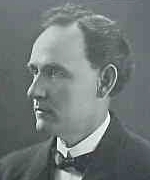
Sidney E. Ellsworth
Justice of the Supreme Court
Appointed: 1909 - 1910
Justice Ellsworth was born September 29, 1862, near Pittsburgh, Pennsylvania, and moved with his parents to Kansas in 1871 and Illinois in 1875. He taught school for a time and then entered law school. He graduated from Valparaiso Law School in 1891 and was admitted to practice. He moved to North Dakota in 1893 and was admitted to practice in North Dakota that same year. He practiced law in Carrington until December 1894. He then moved to Jamestown and continued his practice for about 50 years. The only break during his years of practice was in January 1909, when he was appointed to the Supreme Court by Governor Burke at age 46. His appointment was made pursuant to the constitutional change increasing the number of justices from three to five. Justice Ellsworth was defeated in the 1910 election and returned to his private practice in Jamestown after serving on the Supreme Court one year, eleven and one-half months. From 1936 to 1938 he served as an attorney for the Highway Department. Justice Ellsworth died October 31, 1945, at age 83.
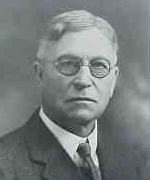
Burleigh F. Spalding
Justice of the Supreme Court
Appointed: 1907 - 1914
Justice Spalding was born in Craftsbury, Vermont, on December 3, 1853. He received his early schooling at Craftsbury and then attended Military School at Norwich University in Northfield, Vermont and received his degree in 1877. He taught school in Vermont and studied law in his spare time. He was admitted to the Vermont Bar and in 1880 he moved to Fargo, Dakota Territory, and was admitted to practice law. Justice Spalding was very active in public life. He served as a member of the Capital Commission of the Dakota Territory; the North Dakota Constitutional Convention; and the 56th and 58th Congress in the years, 1899-1901 and 1903-1905. He was appointed to the Supreme Court January 31, 1907, at age 53, to replace Justice Engerud. He was elected in the 1908 election and served approximately seven years and eleven months until he was defeated in the 1914 general election. He returned to Fargo and engaged in the practice of law in addition to entering the banking field. He was the organizer and first President of Merchants National Bank of Fargo. Justice Spalding died on March 17, 1934, at age 80.
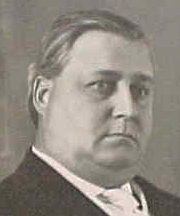
Charles Fisk
Justice of the Supreme Court
Elected: 1907 - 1916
Justice Fisk was born in Morrison, Illinois, on March 11, 1862. He received his elementary and secondary education in the Morrison schools. He then attended Northern Illinois College at Fulton, Illinois, and received his law degree in 1883 at age 21. He came to the Dakota Territory and was admitted to the Bar in 1886 and immediately started a practice in what is now Larimore, North Dakota. Shortly thereafter, he moved to Grand Forks and practiced law until 1897. During this period he served as Grand Forks City Attorney for two years and also functioned as an Assistant United States Attorney. In 1897 he was elected to the position of District Judge for the First Judicial District with chambers in Grand Forks and served in that capacity for ten years. In the 1906 general election he defeated Justice Knauf for the position on the Supreme Court left vacant when Justice Young resigned. He assumed office in January 1907 at age 44 and was reelected to a full term in 1910. He was defeated by Luther Birdzell in the 1916 general election after serving ten years on the Supreme Court. Justice Fisk returned to private practice in Minot, North Dakota. He continued in practice until 1923 at which time he was appointed Referee of the State Guaranty Fund Commission. He served in that position until it was abolished, a short time before his death. Justice Fisk died on May 8, 1932, at age 70.
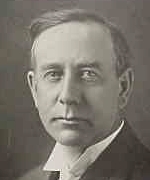
John Knauf
Justice of the Supreme Court
Appointed: 1906 - 1906
Justice Knauf was born in Waterloo, Michigan, on April 5, 1868. His parents died when he was very young and Justice Knauf and his brothers and sisters moved to Stutsman County in 1883. He received his high school education in the Jamestown school system. He spent one year at Jamestown College and one year at St. John's in Collegeville, Minnesota, and then enrolled at the University of Michigan School of Law. He received his law degree in 1892 and was admitted to practice in Michigan. He was admitted to the North Dakota Bar in 1893 and opened an office in Jamestown where, for a time, he served as County Judge for Stutsman County. In 1906, at age 38, he was appointed to the Supreme Court to fill the position left vacant by the resignation of Justice Young. He was defeated in the 1906 election, and after serving four and one-half months on the Court, returned to private practice in Jamestown. Justice Knauf died on September 19, 1952, at age 84.
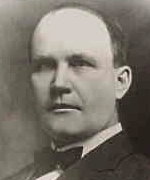
Edward Engerud
Justice of the Supreme Court
Appointed: 1904 - 1907
Justice Engerud was born in Racine, Wisconsin, on February 13, 1868. In 1881 he moved to Fergus Falls, Minnesota, where he took up the study of law for one year. In 1882 he went to Grand Forks, Dakota Territory, and studied law for one year, then returned to Fergus Falls to resume his studies in one of the Fergus Falls law offices. In 1889, at age 21, he was admitted to the Bar in Minnesota and practiced law in Fergus Falls for four years. In 1893 he moved to Lisbon, North Dakota, and was State's Attorney for Ransom County for two years. He moved to Fargo in 1895 and in 1897 was elected as Cass County State's Attorney, an office he held until 1900. He was then appointed Assistant United States District Attorney for a term of four years. He was appointed to the Supreme Court on August 9, 1904, to fill Justice Cochrane's term until the 1904 general election. Engerud was elected to fill out the remainder of Justice Cochrane's term in the 1904 election. He resigned from the Court on January 10, 1907, after serving approximately two years and five months. After his resignation, he returned to private practice in Fargo. He was appointed United States District Attorney in 1910 until 1914. Justice Engerud died on January 8, 1921, at age 52.
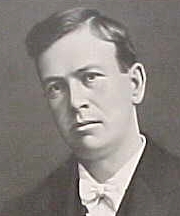
John M. Cochrane
Justice of the Supreme Court
Elected: 1902 - 1904
Justice Cochrane was born on March 11, 1859, in Mt. Pleasant, Westmoreland County, Pennsylvania. In 1861 he moved with his parents to Canton, Illinois, and in 1865 they continued their westward migration, taking up residence in Fairbault, Minnesota. In 1873 they moved to Minneapolis, Minnesota, and in 1876 he attended the State University of Minnesota. In 1879 he entered the law school of the University of Michigan at Ann Arbor. He graduated in 1881 and was admitted to the Bar in the state of Minnesota where he practiced law until March 1883. At that time, he moved to Grand Forks, Dakota Territory, and practiced law until the fall of 1884, when he was elected Probate Judge of Grand Forks County to a two-year term. He was reelected in 1886, but resigned in 1887 to accept an appointment as State's Attorney for Grand Forks County. He was elected to that office in 1888 to a two-year term. He was also a Criminal Law instructor with the College of Law at Grand Forks for a number of years. Justice Cochrane was elected to the Supreme Court in 1902 and after serving only one year and seven months, he died in office at age 45 on July 20, 1904.

David Morgan
Justice of the Supreme Court
Elected: 1901 - 1911
Justice Morgan was born in Coalport, Ohio, on November 8, 1849. When he was a young child his parents moved to Wisconsin and he was educated in the common schools, at Spring Green Academy, and at Plattville State Normal School. He took a special course for a year at Wisconsin State University. After leaving Wisconsin State University he taught school for a time in Ironton, Wisconsin, and later was principal of a Chilton, Wisconsin school. He was elected Clerk of the Court of Sauk County, and during his terms he read law with several judges. He was admitted to practice in Wisconsin in 1879. In 1881 he resigned as Clerk of Court and moved to the Dakota Territory to practice law. In 1883 he moved to Devils Lake and practiced until he was elected Judge of the 2nd Judicial District in 1889. During the period he practiced in Devils Lake, he served four years as State's Attorney for Ramsey County. After 11 years on the District Court Bench he was elected to Justice Bartholomew's position on the Supreme Court in 1900. He was 51 years of age when he came on the Supreme Court and, after serving approximately ten years and eight months, he resigned on August 31, 1911, for reasons of ill health. After retiring, he moved to California where he remained until his death at age 62 on May 11, 1912.

Newton C. Young
Justice of the Supreme Court
Appointed: 1898 - 1906
Justice Young was born January 28, 1862, in Mount Pleasant, Iowa. He received his elementary education in Taber, Iowa; graduated from the Iowa City Academy in 1882; received a bachelor of arts degree at Iowa State University in 1886; and obtained his law degree from the same institution in 1887. He moved to Bathgate, Dakota Territory, in 1887 and practiced law until 1898. During this period of time, he served two terms as County Attorney for Pembina County. As a result of Justice Corliss' resignation, Young was appointed to the Court in 1898 by Governor Devine to serve until the 1898 general election. He was elected to a term in 1898 and was reelected in 1904. He assumed office at age 36 and served approximately seven years, ten and one-half months. He resigned from the Court in 1906 and practiced law in Fargo until his death at age 61 on November 10, 1923.
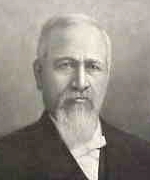
Alfred Wallin
Justice of the Supreme Court
Appointed: 1889 - 1903
Justice Wallin was born in New York on February 12, 1836. He received the majority of his education in Chicago. Justice Wallin received his legal education at the University of Michigan. He was admitted to the Michigan Bar in 1862 and also the Illinois Bar. He served in the Army in 1861 and 1862, reenlisted in 1864, and was finally mustered out in 1865. After the war he moved to Minnesota and practiced in St. Peter and then in Redwood. He held the office of County Attorney in both Nicollet and Redwood Counties. In 1883, he moved to Fargo, Dakota Territory, and practiced law until elected, at age 53, as one of the first three justices of the North Dakota Supreme Court. He received a seven-year term and was reelected in 1896. Justice Wallin retired at the end of his term on December 31, 1902, after having served approximately 13 years and one month. He had declined renomination and did not resume private practice because of his increasing deafness. Justice Wallin died January 9, 1923, at age 86.
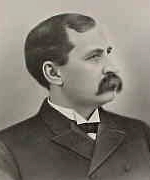
Joseph Bartholomew
Chief Justice/Justice of the Supreme Court
Elected: 1889 - 1901
Justice Bartholomew was born June 17, 1843, in Clarksville, Illinois. When he was two years old he moved with his parents to Lodi, Wisconsin, and was educated in the Lodi Public Schools. At age 18 he entered Wisconsin State University. His higher education was interrupted when he enlisted in the Army in August 1862 and served until November 1865. After the war he took up the study of law in the office of a Des Moines, Iowa, attorney. In 1869, he was admitted to practice at Dubuque, Iowa. After admittance he returned to Lodi, Wisconsin, for a short time and then returned to Iowa and practiced in Red Oak. Justice Bartholomew moved to LaMoure, Dakota Territory, in 1883 and practiced law until he was elected to the Supreme Court in 1889. He was one of the first three justices elected and received a five-year term. He assumed office for the first time at age 46, and was reelected in 1894. He retired at the end of his term on December 31, 1900, and returned to private practice after approximately 11 years and one month on the Bench. Justice Bartholomew died unexpectedly on March 24, 1901, at age 57.
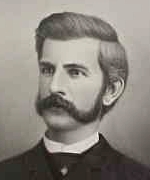
Guy C. H. Corliss
Chief Justice/Justice of the Supreme Court
Elected: 1889 - 1898
Justice Corliss was born in Poughkeepsie, New York, on July 4, 1858. He received his elementary education in Poughkeepsie and graduated from Poughkeepsie High School in 1873 at age 15. He was then employed as a clerk in a store and, at the same time, studied law in the office of a Poughkeepsie attorney. He was admitted to the New York Bar in September of 1879 at age 21. He then practiced law in New York from 1879 to 1883. In 1883, he moved to Grand Forks, Dakota Territory, and practiced law until he was elected to the Supreme Court of North Dakota in 1889. He was 31 years old when elected as one of the first three justices to the Court, and he served approximately eight years, eight and one-half months. He resigned from the Court August 15, 1898, and returned to Grand Forks to practice law and, with the aid of President Webster Merrifield of the University of North Dakota, organized the School of Law. Justice Corliss became the first Dean of the School of Law and served in that capacity from 1899 until 1902. He then returned to the practice of law but remained as part-time Professor of Law until 1912 when he left the state. The Phi Alpha Delta National Legal Fraternity organized a chapter at the Law School and it was named the Guy C. H. Corliss Chapter. Justice Corliss received a Doctor of Laws degree from the University of North Dakota in 1930. On November 24, 1937, at age 79, Justice Corliss died in Portland, Oregon.

